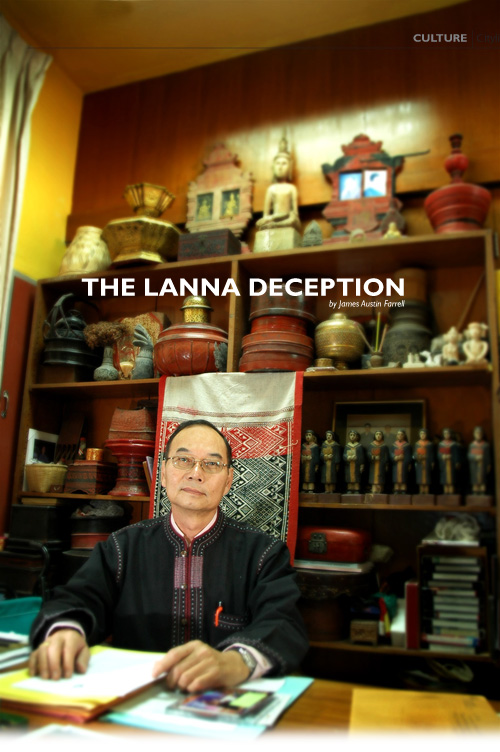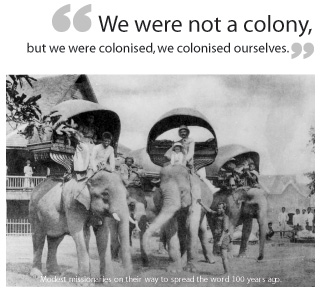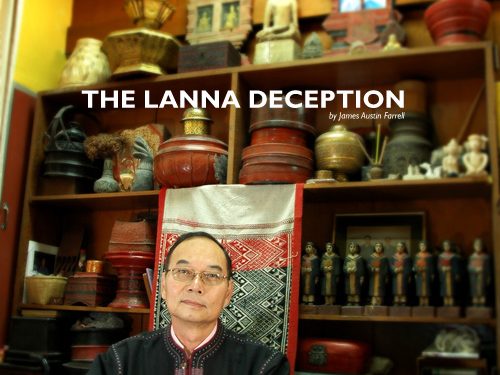
“Yes, what is Lanna?” pondered ajarn Vithi, a remarkably youthful looking man for his sixty plus years, as he fiddled with some slides at his office in the Faculty of Arts, Chiang Mai University, “most people are vague about that . . . It’s become so commercialised, people have lost their way.”
Vithi Phanichphant, a dedicated historian and highly respected authority on northern Thai culture is as controversial as he respected, as cynical as he is idealistic. Born in Lampang in 1946 the ajarn had a varied education, his formative years were spent studying in Bangkok, then in his later teens he studied at Queen’s College in Hong Kong. His BA in Art was taken at the University of California and so too was his MA in Environmental Design. After his studies he came back to Chiang Mai and held various teaching positions; it is here in this city where his reputation as an assiduous, and often critical, scholar grew. He has lectured all over the world (he was called and asked to give a speech to GMs of hotels on Thai culture during this interview) on Thai art, Thai culture, Thai textiles; he’s published works on art and culture, as well as been commissioned for various design projects, and producing/directing traditional Thai ceremonies from weddings to funerals. He is, in the modern sense, quite a legend considering his fortitude and avidity to restore and replenish northern Thai art and culture. So why is it he is often the focus of controversy, maligned, and effortfully disliked by a certain segment of Thai society?
“Someone once said I ruined the whole culture here,” explained Vithi, looking quite amused, before he went on to expatiate the foundations of the Chiang Mai art academies.
“In 1983 we were granted to start an art department at CMU, up until then art had not even been in their thinking, when we started we were just two ajarn. I had one class and the other ajarn had the other class. One class was Fine Arts and the other class Thai Art.” Thai art, as a subject, did not exist, and this course was the first of its kind in the world, though Vithi had the Thai government worried, “The ministry of education worried about us setting up this Thai art department, teaching northern art and northern culture, they thought we might be separatists.” To placate the government’s concerns it was then agreed that he would teach ‘national Thai art’, though with a certain emphasis on northern art. “This was the beginning of art in Chiang Mai,” says Vithi, though he added that students didn’t want to learn about Thai art, they wanted to study western art. “They had a misconception of Thai art, they didn’t really know what it was. So my course was not about teaching Thai drawings, it focused on knowledge, investigation the ethnicity of Thais. Soon my students were coming back to me with all kinds of information on Thai art and culture, they were teaching me things I didn’t know.”

Lanna Inc.
1996 was the year of the Lanna revival. It was 700 years since Chiang Mai had been in existence, the city that was at the centre of the Lanna Kingdom.
“Lanna is cooked up, the word was pretty much unheard of before 1996, it was not used as the name of any kingdom,” said the ajarn adding, “Lanna may have been a name or a title, like the builder of Doi Suthep was called ‘Gunna’ meaning ten million rice fields. The name has been revived as the name of this so called kingdom, but there was no such place in the past . . . people would not have said ‘I am Lanna’ or ‘this’ or ‘that is Lanna’.”
During his time with the art department, where he later became head, he encouraged his students to unearth facts concerning the history of the north of Thailand. From all the information they gleaned through the study of local art, textiles, ceramics, laquarware, domestic architecture and crafts, they traced the history of what is now called Lanna. “This was a whole new approach for regional studies, trying to understand the ethnology of the Thais. We had always been told there was just one kind of Thai, that’s how our history teaches us. If you read Thai history books they will tell you we all come from the Altai mountains!” These mountains on the hinterlands of Russia and Mongolia, according to the ministry of education, are where ALL Thais descended from. “The government did not want people to know about their ethnicity, they wanted a unified, centralised, Thailand; it’s the policy of the government to teach one country, one flag. We used to see signs saying ‘This area is free from local dialect.’ We were supposed to speak Central Thai only. Not many people in the north were even aware of their cultural background, they didn’t know that they were Tai Daeng, Tai Dam, Tai Laos or Tai Lue.”
“It’s a joke,” Vithi says, of the erroneous knowledge provided to people of their own history, “and they haven’t tried to inject a correct version of Thai history into the education system.” But the art department and its students prevailed somewhat in teaching the people of Chiang Mai something of their origins. The students would help with local ceremonies, processions, offerings and regional cultural activities, giving advice on dress and ceremonial procedure, even on the colour and texture of various ornaments, bowls etc. “This gave the students something to do after they graduated, what else could they do afterwards? We helped put these ceremonies back together, adding the traditional to the contemporary.” The department helped deconstruct and reinvigorate local music and dance, as well as bring back costumes that locals were unaware their forefathers ever donned. These cultural, ethnic idiosyncrasies, it became evident, were very attractive to westerners, to both expats and tourists. A market was born, Lanna Inc. suddenly became the most lucrative business in Chiang Mai.
Vithi gives an example of how Lanna has been successfully marketed to foreigners and Tha?s alike: “I helped start khantoke in 1972, this was after the first khantoke took place in 1953 when Krai Sri Nimmanhaeminda held a party at his house to show traditional northern culture to foreign and Thai dignitaries. Khun Oun, his younger sister, later went to Hawaii and brought back Hawaiian traditional dance [a luau] and mixed this with Tai Lue traditions to make the khantoke we see today. It is not Lanna, but Hawaiian and Tai Lue.”
“Businesses today don’t know what they are doing, they mix everything up, they don’t have proper information . . . they confuse traditional local costume with Burmese or Siamese or even Hindu.” Later he calls this bastardisation of culture a “South East Asian buffet of costumes to entertain ignorant tourists.”
“They call everything Lanna, because Lanna sells, but its too much, pushing it too far.” What we are presently selling as Lanna tranquility, Lanna unity, peace, harmony, spirituality, is in fact, according to Vithi, a load of old cobblers. “The different tribes and states of the north (Lanna) all had different accents and dialects, you could tell where someone was from by the way they spoke. We were all rivals, it’s bullshit,” he says of the peace and harmony, “we were always fighting and overrunning each other.” But because of the Silk Road he says people were generally friendly towards visitors and passers through. “People made money from the caravans so we accommodated trade routes, we weren’t often hostile to foreigners.” Women, he says, were especially friendly to traders and visitors. Vithi explains that the “sticky rice eaters” (certain ethnic groups around South East Asia) were, and are, a matrilineal culture, one of the only ones left in South East Asia. “Just look at the Chamber of Commerce in Chiang Mai, there are more women than men, most of them are the Nimmanahaeminda family, Kamtiang is the grand matriarch. If you pull the string behind the bamboo curtain you’ll see how much of Chiang Mai business is owned by women. This must be part of our understanding too, the fact that much of our so called Lanna is a matrilineal culture.”
The West is the Best?
After ’96 the tube skirt (phasin) was brought back into the consciousness of the northern people but as Vithi says, “nobody wanted to wear it, they thought it was for servants. The image of Thai culture was a Thai Airways air hostess in a Jim Thompson catalogue dressed in silk, it was very hard to get girls to wear the wraps, people were saying that this style was hill tribe, not Thai.” But through cultural footnotes, photos, pictures and paintings it was evident that girls did wear tube skirts, it was also evident that many often went completely topless. Vithi upset the apple cart after he produced a cultural show where men wore loin cloths and had tattoos, and the women reflected their topless past by simply wrapping a cloth around their breasts, baring their stomachs and shoulders. “This caused a lot of controversy at the time. People were concerned about the nakedness, they wanted to be idealistic about their past. But we had followed the Thai DNA, we had investigated the past.”
“The missionaries taught modesty, and in the Thai courts in Bangkok people became familiar with Victorian England, as more royals studied there. There was a royal decree sent to Chiang Mai in the early twentieth century ordering women to ‘cover up’. Men even had to cover their tattoos.” After the decree, Vithi explains, that girls started to wear blouses, while the ministry of culture went one step further and expressed that all women should “wear hats and kiss their husbands before they went to work . . . they were also ordered to cut down all the betel nut trees.” This is what the ajarn calls the ‘European Effect’, Thai norms and traditions, especially those of the northern tribes, had become unseemly and before you could say ‘cultural totalitarianism’ stained red teeth and exposed overworked nipples were outlawed. The controversial ajarn adds, “The ministry tried to create a new culture that was more ‘civilised’, and attempted to obliterate the old culture.”
This period was the beginning of the widespread westernisation of Thailand. School girls were taught to wear their hair in bob styles, emulating what the ajarn dubs the “Gatsby look”. All over Thailand western vogue became fashionable, ethnic roots were pulled, and were supplanted by what the west deemed civilised, attractive, normal. “We were not a colony, but we were colonised, we colonised ourselves,” says Vithi emphatically.
He admits that people don’t want to return to the old ways, but fears people have forgotten their traditions, or are embarrassed of their own ethnicity. “Ceremonies could come back in modern traditional culture, there can be a modification of the old culture into contemporary use.” Laughing, he explains that twenty years ago girls would not expose their stomachs and wear a Tai Lue short top, though right now the “girls will happily wear them with skin exposed” in adherence to the modern scantiness of female dress sense.
Vithi explains that Thai culture has grafted onto it western technology and ideology without having been through two hundred years of industrialisation, without a renaissance, without a strong academic background in science, philosophy, art. “We have gone from the Middle Ages to mobile phones, we missed the industrial revolution. We went from telling the time by the sun and moon to the cell phone.” He ascribes Thai people’s well known tardiness to the fact they never got used to watches and telling the time. “People still use the sun,” he says, adding, “culture has moved too fast.”
“We do not understand the real value of our own culture, we might own it but we don’t know how to handle it, we’ve twisted it to the benefit of ourselves and some things have been twisted too far. We should take a reverse gear and look at what we are doing, take a closer look at what we had, before we jump forward. We have to understand our valuable heritage.”
Related Articles
Unseen Lanna 2018 (Happening Now)
Putting Down Roots: How the Tai Yai are making a home for themselves
The Next Steps of UNESCO Chiang Mai Creative City
